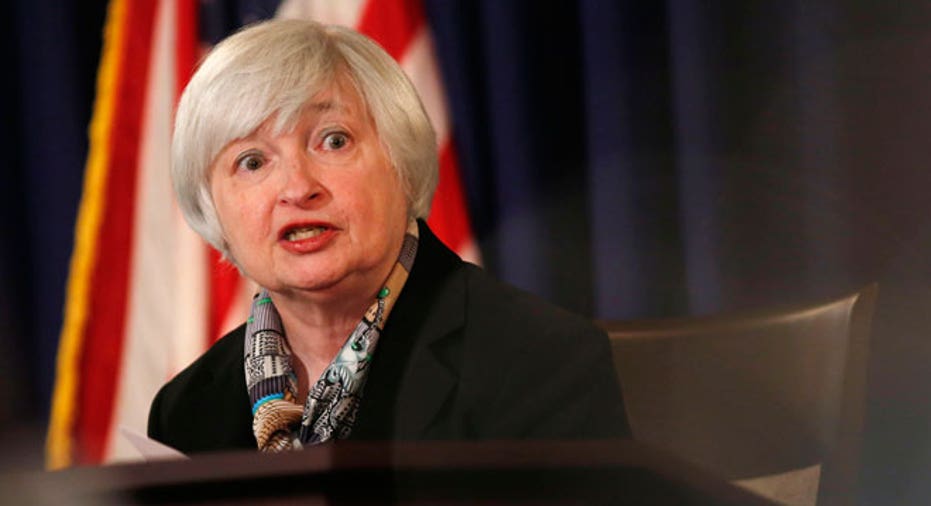FOMC Meeting: Looking For Clues On Rate Hikes

It’s all about the timing and trajectory of interest rate hikes.
The Federal Reserve won’t be raising interest rates at the conclusion of its two-day meeting this week. But Fed members are widely expected to start laying the groundwork for an eventual rate hike by adjusting their long-range economic forecasts.
The policy-setting Federal Open Market Committee meets Tuesday and Wednesday and will issue a statement announcing any policy shifts at 2 p.m. Wednesday. Fed Chair Janet Yellen will hold a press conference a half-hour after the statement is released.
No one expects any surprises from Wednesday’s announcement: the Fed will keep interest rates at their historically low range of 0%-0.25%, part of an accommodative set of policies put in place in the wake of the 2008 financial crisis; and the Fed will continue to gradually taper its bond purchases, cutting the amount by another $10 billion a month to a total of $35 billion each month.
What the markets will be looking for are clues as to when and how the Fed will begin raising rates.
Conventional wisdom holds that the Fed will start raising interest rates at some point in mid-2015. That hasn’t changed. What might change is the projected speed – or trajectory – at which interest rates go up once the Fed pulls the trigger and starts lifting them from their current historic lows.
Jeremy Lawson, chief economist at Standard Life Investments, said the markets have currently priced in a slow increase in rates. “I think that needs to be adjusted,” he said, citing an array of economic indicators that suggest the economy is “edging closer to the Fed’s goals of full employment and price stability.”
Inflation, for example, is ticking higher: the Labor Department said on Tuesday its Consumer Price Index increased 0.4% in May, with food prices posting their largest rise since August 2011.
The Fed has sought an increase in inflation as a prerequisite for moving interest rates higher.
Given the current focus on rate hikes, the portion of Wednesday’s statement that will garner the most attention will be the forecasts provided by the 16 Fed policy makers asked to project their views for the long-range health of the U.S. economy.
If those forecasts on the whole are more optimistic than previous forecasts offered by the Fed, it will fuel speculation that the Fed will move interest rates higher sooner rather than later.
Sooner, Faster, Higher
David Kelly, chief global strategist at JPMorgan Funds, said recent strengthening in the labor markets could lead Fed policy makers to lift their longer-range expectations, making it more likely they will “bring forward the timing and perhaps trajectory of increases in the Federal funds rate.”
In other words, the key Fed funds rate, the rate at which banks charge each other for overnight loans, could not only start moving higher sooner than expected but also rise faster than previously predicted.
In March, the Fed predicted interest rates will have risen to 1% by the end of 2015, and to 2.25% by the end of 2016. Kelly believes both of those figures could rise by 0.25% “or more” when the latest forecasts are released on Wednesday.
The same internal Fed debate that hovered for months over tapering is now focused on raising interest rates.
So-called inflation doves, led by Yellen and her newly appointed vice-chair Stanley Fischer, support extending the accommodative measures put in place after the crisis until the economy has proven it can stand on its own.
In recent years, the economy has recovered in fits and starts, leaving the Fed to backtrack on its own policy forecasts on a handful of occasions. That’s made the Fed more cautious in predicting timetables for significant policy shifts.
The economic guidelines offered most recently by Yellen for when rates might start moving higher are an unemployment rate in a range of 5.2% to 5.6% and inflation at a range of 1.7% to 2%. That should happen by mid-2015.
Despite the unemployment rate tumbling rapidly in recent months to its current level of 6.3%, broader economic indicators have pointed up weaknesses in the recovery -- first-quarter GDP, which showed a decline in production, is one such measure.
The inflation doves don’t want to phase out the Fed’s accommodative policies before the economy is ready to run without them.
Meanwhile, inflation hawks, among them Kansas City Fed President Esther George, have long expressed skepticism of the Fed’s easy-money policies, fearing if the bond purchases and low interest rates are left in place too long they will bring on runaway inflation.
That debate is still underway at the Fed, and Wednesday’s statement could reveal which side is winning.



















